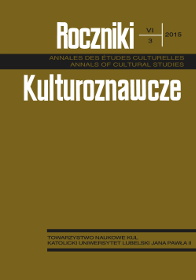Archaeology of Jerusalem in the Time of Jesus: Introducing the Need for “Archeologically Enriched Theology”
Abstrakt
Archeologia Jerozolimy w czasach Jezusa: O potrzebie „archeologicznie wzbogaconej teologii”
Bibliści i teologowie powinni wzbogacić i ożywić swą teologię poprzez dodanie licznych godnych uwagi spostrzeżeń archeologicznych (zwłaszcza z Morza Martwego) i metod, takich jak socjologia. W ten sposób zmniejszy się antysemityzm, będący prawdopodobnie najgorszą herezją w teologii chrześcijańskiej, gdy uczeni zauważą, że Jezus był wiernym Żydem, przywiązanym do Pisma Świętego i oddającym cześć Bogu w Świątyni. Będziemy współpracować również, aby usunąć doketyzm z naszych kościołów i szkół. Jest to najwcześniejsza herezja, której brakuje przenikliwości Jana (1,14). Pomija fakt, że Jezus był człowiekiem z krwi i kości. Oba nowe spojrzenia są zgodne z nauczaniem Jana Pawła II, cenionego świętego, który ukazał mi miłość Boga.
Bibliografia
Aviam, Mordechai. Jews, Pagans and Christians in the Galilee. Rochester: University of Rochester Press, 2004.
Aviam, Mordechai. “The Book of Enoch and the Galilean Archeology and Landscape.” In Parables of Enoch, edited by Darrell L. Bock and James H. Charlesworth, 159–69. T & T Clark Jewish and Christian Texts Series 11; London, New York: Bloomsbury, 2013.
Avigad, Nahman. Discovering Jerusalem. Jerusalem: Shikmona and Israel Exploration Society, and Nashville: Thomas Nelson, 1983
Bahat, Dan. The Jerusalem Western Wall Tunnel. Jerusalem: Israel Exploration Society, 2013.
Brooke, Georg J. Reading the Dead Sea Scrolls: Essay in Method. SBL Early Judaism and Its Literature No. 39; Atlanta: SBL 2013.
Bultmann, Rudolf. Theology of the New Testament, translated by Kendrick Grobel, vol. 1. New York: Charles Scribner’s Sons, 1951.
Charlesworth, James H. In Anti-Judaism and the Fourth Gospel: Papers of the Leuven Colloquium, 2000, edited by Reimund Bieringer et al., 479–513. Assen: Royal Van Gorcum, 2001.
Charlesworth, James H. “Does Archaeology Help Christian Belief?” In Origins Matter. Manila: Catholic Biblical Association of the Philippines, 2009.
Charlesworth, James H. “Archaeology and the Passion of Jesus.” Scripture and Interpretation 4.1 (2010): 45–68.
Charlesworth, James H. “Jesus Research and Archaeology.” In The World of the New Testament, edited by Joel Green and Lee Martin McDonald, 439–66. Grand Rapids: Baker Academic, 2013.
DeSalvo, John. The Dead Sea Scrolls: Their History and Myths Revealed. New York: Shelter Harbor Press, 2014.
Evans, Craig A. Guide to the Dead Sea Scrolls. Nashville: Holman Reference, 2010.
Flint, Peter W. The Dead Sea Scrolls. Core Biblical Studies. Nashville: Abingdon Press, 2013.
Herod the Great: The King’s Final Journey, edited by Silvia Rozenberg and David Mevorah. Jerusalem: The Israel Museum, 2013.
Herod: The Life and Death of the King of Judea, edited by Yadin Roman.Tel Aviv: Eretz Ha-Tsvi 2013.
Hirschfeld, Yizhar. Ramat Hanadiv Excavations. Jerusalem: The Israel Exploration Society, 2000.
Horowitz, Ahron. City of David: The Story of Ancient Jerusalem, 3rd ed. Jerusalem: Megalim, 2010.
Jammer, Max. Einstein and Religion. Princeton: Princeton University Press, 1999.
Jesus and Temple: Textual and Archaeological Explorations, edited by James H. Charlesworth. Minneapolis: Fortress, 2014.
Jesus Research: New Methodologies and Perspectives, edited by James H. Charlesworth with Brian Rhea and Petr Pokorný. Grand Rapids: Eerdmans, 2014.
Kam, Vander, The Dead Sea Scrolls and the Bible. Grand Rapids: Eerdmans, 2012.
Küchler, Max. Jerusalem: EinHandbuch and StudienreiseführerzurHeiligenStadt. Orte und Landschaften der Bibel 4.2. Göttingen: Vandenhoeck & Ruprecht, 2007.
Mazar, Eilat et al. The Walls of the Temple Mount. Jerusalem: Shoham Academic Research and Publication, 2011.
McDonald, Lee Martin. Formation of the Bible: The Story of the Church’s Canon. Peabody, MA: Hendrickson, 2012.
Merleau-Ponty, Maurice. Phenomenology of Perception, translated by Colin Smith. London: Routledge & Kegan Paul; New York: The Humanities Press, 1962.
Netzer, Ehud. The Architecture of Herod, the Great Builder. Tübingen: Mohr Siebeck, 2006.
Porath, Yosef. Caesarea Maritima. Volume I: Herod’s Circus and Related Buildings. Part I: Architecture and Stratigraphy. IAA Reports no. 53. Jerusalem: Israel Antiquities Authority, 2013.
Ritmeyer, Leen. The Quest: Revealing the Temple Mount in Jerusalem. Jerusalem: Carta, 2006.
Rozenberg, Silvia. “Interior Decoration in Herod’s Palaces.” In Herod the Great: The King’s Final Journey, edited by Silvia Rozenberg and David Mevorah, 166–223. Jerusalem: The Israel Museum, 2013.
Stacey, David, and Gregory Doudna with Gideon Avni. Qumran Revisited: A Reassessment of the Archeology of the Site and its Texts. BAR International Series 2540. Oxford: Archaeopress, 2013.
The Bible and the Dead Sea Scrolls, edited by James H. Charlesworth, 3 vols. Waco: Baylor University Press, 2006.
The Oxford Handbook of Apocalyptic Literature, edited by John J. Collins. Oxford: OUP, 2014.
The Oxford Handbook of Jewish Daily Life in Roman Palestine, edited by Catherine Hezser. Oxford: OUP, 2010.
The Oxford Handbook of the Dead Sea Scrolls, edited by Timothy H. Lim and John J. Collins. Oxford: OUP, 2010.
Vermes, Geza. The Story of the Scrolls. London: Penguin Books, 2010.
Viereck, George Sylvester. “What Life Means to Einstein.” Saturday Evening Post 26, October 1929.
Walking Though the Land of the Bible: Historical 3D Adventure, edited by James H. Charlesworth and Michael Medina. Jerusalem: The Hebrew University Magnes Press, 2014.
What has Archaeology to do with Faith?, edited by James H. Charlesworth and Walter P. Weaver. Faith & Scholarship Colloquies; Philadelphia: Trinity Press International, 1992.





